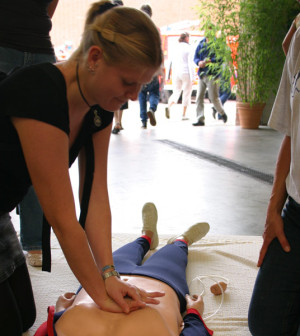- Skip Storing This Everyday Product in the Fridge Door
- Green Tea + B3 Pairing May Boost Brain Health
- Navigating Your Midlife Crisis: Embracing New Possibilities
- City Raccoons Showing Signs of Domestication
- Mapping the Exposome: Science Broadens Focus to Environmental Disease Triggers
- One Week Less on Social Media Linked to Better Mental Health
- Your Brain Changes in Stages as You Age, Study Finds
- Some Suicide Victims Show No Typical Warning Signs, Study Finds
- ByHeart Formula Faces Lawsuits After Babies Sickened With Botulism
- Switch to Vegan Diet Could Cut Your Greenhouse Gas Emissions in Half
Better-Educated Public May Bring More Lifesaving CPR, Study Shows


TUESDAY, Oct. 1Research out of Denmark suggests that when more lay people learn CPR, survival rates for cardiac arrest go up.
“Cardiopulmonary resuscitation, or CPR, keeps a person’s blood and oxygen pumping to the brain and heart until help can arrive in an emergency. About 80 percent of all cardiac arrests happen somewhere other than in a hospital,” noted one U.S. expert not connected to the study, Dr. Joseph Anthony Zito.
“Learning this lifesaving technique improves a victim’s chance of survival,” said Zito, who is associate director of the ICU at North Shore-LIJ’s Franklin Hospital in Valley Stream, N.Y. “When someone is in cardiac arrest seconds count and it is imperative for survival that CPR be initiated immediately.”
In recent years, Denmark has launched several programs to boost the number of people who provide CPR to cardiac arrest victims, and more than 15 percent of the Danish population took CPR courses between 2008 and 2010, note a team led by Dr. Mads Wissenberg of Copenhagen University Hospital Gentofte.
“In many cases, time from recognition of cardiac arrest to the arrival of emergency medical services is long, leaving bystanders in a critical position to potentially influence patient prognosis through intervention before EMS arrival,” the Danish team said. “However, only a minority of cardiac arrests receive bystander CPR.”
In the new study, Wissenberg and colleagues examined data from more than 19,400 people who suffered an out-of-hospital cardiac arrest during the past 10 years. The median (midpoint) age of the patients was 72, and about two-thirds of them were men.
During the study period, the number of cardiac arrest victims who received CPR from bystanders at the scene rose from about 21 percent to nearly 45 percent, the researchers reported in the Oct. 2 issue of the Journal of the American Medical Association.
The proportion of cardiac arrest patients who were alive when they arrived at hospital also rose, from about 8 percent to almost 22 percent over the same time period, the study found. There were also increases in 30-day (3.5 percent to 10.8 percent) and 1-year (2.9 percent to 10.2 percent) survival rates.
The authors note that there was only a small increase (1.1 percent to 2.2 percent) in the number of victims treated with an automatic defibrillator by bystanders.
Denmark has launched other programs recently to help cardiac arrest patients, so it’s unclear whether there’s a direct link between the growing number of people with CPR training and improved survival after out-of-hospital cardiac arrest, the researchers said.
Another U.S. expert said the Danish study has relevance for Americans.
“This is the first time that cardiac resuscitation efforts have been initiated nationally,” explained Dr. Kenneth Ong, interim chief of cardiology at the Brooklyn Hospital Center, in New York City. “The results from this study are impressive and demonstrate its feasibility.”
“Overall, this study speaks to the efficacy of bystander intervention in improving patient survival after out-of-hospital cardiac arrest,” Ong said. “It is worthwhile to consider a similar effort in this country.”
He added that, “one of the most fascinating findings is the low use of AEDs (automated external defibrillators) in impacting the results of this study, a technology that has been emphasized in the U.S.”
Zito agreed that when heart emergencies occur, time is crucial.
“If no one performs lifesaving measures on a victim, brain death will begin about four to six minutes after breathing ceases and oxygen stops circulating,” he said. “CPR done immediately and effectively can double the victim’s chance of survival.”
Each year, about 300,000 people in North America suffer an out-of-hospital cardiac arrest. Less than 8 percent of them survive until they’re discharged from the hospital, according to background information in the study.
More information
The American Academy of Family Physicians has more about CPR.
Source: HealthDay
Copyright © 2025 HealthDay. All rights reserved.










